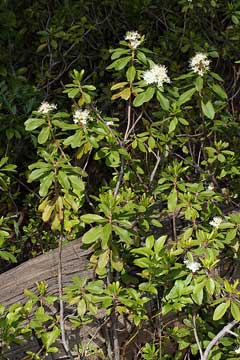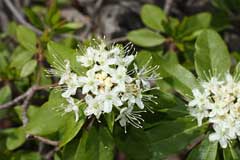 |
|
http://commons.wikimedia.org/wiki/User:Wsiegmund |
 |
| http://commons.wikimedia.org/wiki/User:Wsiegmund |
Translate this page:
Summary
Physical Characteristics

 Ledum glandulosum is an evergreen Shrub growing to 1.5 m (5ft). It is in leaf all year, in flower in May. The species is hermaphrodite (has both male and female organs).
Ledum glandulosum is an evergreen Shrub growing to 1.5 m (5ft). It is in leaf all year, in flower in May. The species is hermaphrodite (has both male and female organs).
Suitable for: light (sandy), medium (loamy) and heavy (clay) soils. Suitable pH: mildly acid soils and can grow in very acid soils.
It can grow in full shade (deep woodland) semi-shade (light woodland) or no shade. It prefers moist soil.
UK Hardiness Map
US Hardiness Map
Synonyms
Plant Habitats
Woodland Garden Dappled Shade; Shady Edge; not Deep Shade;
Edible Uses
Edible Parts: Leaves
Edible Uses: Condiment Tea
An aromatic tea is made from the fresh or dried leaves[172, 183, 257]. The dried leaves are often mixed with non-aromatic leaves such as comfrey[183]. Some caution is advised, see the notes above on toxicity. It would be better to brew the tea in cold water by leaving it in a sunny place, or to make sure that it is brewed for a short time only in an open container. The leaves are used as a flavouring, they are a bayleaf substitute[172]. The fresh leaves can be chewed[183].
References More on Edible Uses
Medicinal Uses
Plants For A Future can not take any responsibility for any adverse effects from the use of plants. Always seek advice from a professional before using a plant medicinally.
Astringent Diaphoretic Diuretic Laxative Stomachic
The leaves and young flowering shoots re astringent, diaphoretic, diuretic, laxative and stomachic[172].
References More on Medicinal Uses
The Bookshop: Edible Plant Books
Our Latest books on Perennial Plants For Food Forests and Permaculture Gardens in paperback or digital formats.

Edible Tropical Plants
Food Forest Plants for Hotter Conditions: 250+ Plants For Tropical Food Forests & Permaculture Gardens.
More

Edible Temperate Plants
Plants for Your Food Forest: 500 Plants for Temperate Food Forests & Permaculture Gardens.
More

More Books
PFAF have eight books available in paperback and digital formats. Browse the shop for more information.
Shop Now
Other Uses
References More on Other Uses
Cultivation details
Requires a lime-free loam or peaty soil[1, 11]. Prefers a moist humus-rich acid soil in shade or semi-shade[200]. Plants flower more freely when grown in a sunny position. Plants grow better if they have certain fungal associations in the soil. The best way of providing this is to incorporate some soil from around well-growing established plants into the soil for the new plant[200]. Hardy to at least -15°c[200]. The leaves are covered in tiny spots or glands from which a strong, resinous scent is given off[245]. The flowers also have an aromatic perfume[245]. Plants benefit from removing the dead flowers before they set seed[188]. This prevents them putting too much energy into seed production at the expense of more flowers and leaves.
References Carbon Farming Information and Carbon Sequestration Information
Temperature Converter
Type a value in the Celsius field to convert the value to Fahrenheit:
Fahrenheit:
The PFAF Bookshop
Plants For A Future have a number of books available in paperback and digital form. Book titles include Edible Plants, Edible Perennials, Edible Trees,Edible Shrubs, Woodland Gardening, and Temperate Food Forest Plants. Our new book is Food Forest Plants For Hotter Conditions (Tropical and Sub-Tropical).
Shop Now
Plant Propagation
Seed - surface sow in a shady part of the greenhouse in February or March[78, 113]. Another report says that the seed is best sown in the autumn as soon as it is ripe[188]. Germination is variable and can be quite slow. Prick out the seedlings into individual pots as soon as they are large enough to handle and grow the pots on in a shady frame for 18 months before planting them out into their permanent positions[78]. Cuttings of half-ripe wood, 5 - 8cm with a heel, July/August in a frame. Plant out in spring. Fair percentage[78]. Cuttings of mature wood, November/December in a frame[113]. Layering in the autumn. Takes 12 months[78]. Division.
Other Names
If available other names are mentioned here
Native Plant Search
Search over 900 plants ideal for food forests and permaculture gardens. Filter to search native plants to your area. The plants selected are the plants in our book 'Plants For Your Food Forest: 500 Plants for Temperate Food Forests and Permaculture Gardens, as well as plants chosen for our forthcoming related books for Tropical/Hot Wet Climates and Mediterranean/Hot Dry Climates. Native Plant Search
Found In
Countries where the plant has been found are listed here if the information is available
Weed Potential
Right plant wrong place. We are currently updating this section.
Please note that a plant may be invasive in one area but may not in your area so it’s worth checking.
Conservation Status
IUCN Red List of Threatened Plants Status :

Growth: S = slow M = medium F = fast. Soil: L = light (sandy) M = medium H = heavy (clay). pH: A = acid N = neutral B = basic (alkaline). Shade: F = full shade S = semi-shade N = no shade. Moisture: D = dry M = Moist We = wet Wa = water.

Expert comment
Author
Nutt.
Botanical References
1160200
Links / References
For a list of references used on this page please go here
Readers comment
© 2010, Plants For A Future. Plants For A Future is a charitable company limited by guarantee, registered in England and Wales. Charity No. 1057719, Company No. 3204567.